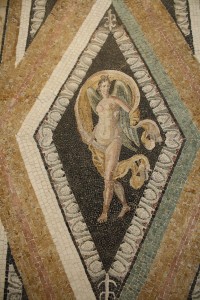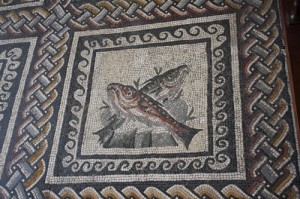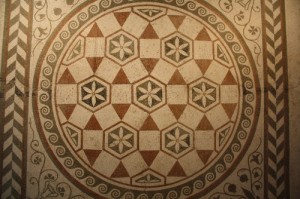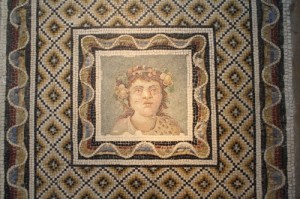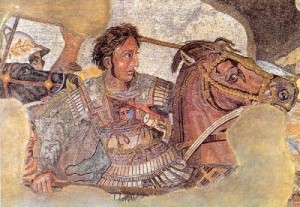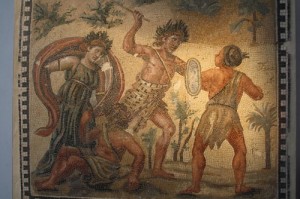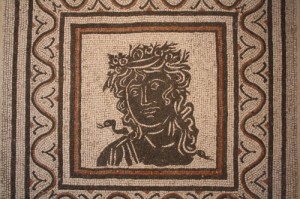Above is a fine example of a mosaic depicting a Roman woman or a goddess.
Roman mosaics, the very words conjure visions of beautiful women or goddess floating almost ethereally, or delicious fish swimming in the sea,
or eye entrancing geometric patterns.
Every home that aspired to be the home of someone worth knowing had them. They have been found in Israel, in Africa, in Spain, in France, and, of course, in Italy. They graced the floors of not only private homes, but also temples, and public buildings. They covered every subject from birds, to animals, to flowers, to clothing, to tools, to portraits, to gladiators, to senators, to hunting, to fishing, and to plowing. Our knowledge of the Roman era would be markedly less visual and less exciting without the world of the mosaic.
Mosaics are composed of small squares of material, usually, with each square being called a tesserae or a tessellae in Latin. The process of making a mosaic was called opus tesellatum. Each tesserae was white, black or colored and measured about 1 cm, although examples range from .5 cm to 1.5 cm. Further, a tesserae could be made from marble, tile, glass, pottery, stone, or sea shells. Sometimes glass was crushed and then made into a paste called smalto.
When one made a mosaic, the first step was to clear a level space and then place fresh mortar over it. The tesserae were then fitted closely together and pushed into the drying mortar. The mortar was made of quick lime and water to first make putty. To the putty, the Romans added sieved sand and crushed stone. After the tesserae were laid, any gaps were filled with further mortar. The mosaic was then left to dry. Later, the mosaic was cleaned and then polished.
As an art form, the Roman raised the art of mosaics to the point that portraits that copied paintings could easily be made. Shading could be incorporated into a mosaic, as well as a complete spectrum of colors.
The following is an example of a portrait with shading:
In time, mosaics were made in a rimmed tray about 40 by 40 cms. These rimmed trays were called in Latin emblemata. Because they were made in a tray, they could be reused time and time again and were handed down from generation to generation. They were quite costly to produce and were highly treasured.
Mosaics were made depicting gods and goddesses, as well as heroes. For example, the following is a depiction of Alexander the Great:
Or Mosaics could be made depicting scenes of battle:
In Italy, black and white mosaics dominated the scene, although there are plenty of colored mosaic examples. Often, these were made with marine themes. In the Roman Baths of Caracalla in Rome, the first floor is covered with such black and white mosaics with an abundance of marine imagery.
Flooring could be done with black and white mosaics, with red mortar to provide more color. Often these were done in geometric forms and were called opus signinum. Of course, mosaics were not only confined to floors, but could be on walls as a mural or even on the ceiling of vaults.
An example of an opus signinum:
Our world be far less complete without beautiful Roman mosaics.
